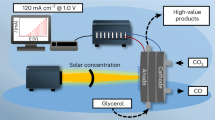Abstract
The minimization of interfacial recombination losses is a key factor in the operation of any semiconductor-based solar-energy-conversion device, including solid-state junctions, semiconductor/liquid junctions and colloidal suspensions of semiconductors. A frequently cited advantage of semiconductor/liquid junctions is the ability to manipulate surface recombination rates by chemical reactions1–7. A notable example is the improvement in current–voltage properties of n-GaAs photoanodes which have been exposed to aqueous solutions of Ru3+ ions8–10. Here we report new surface-modification procedures for GaAs which have produced the most efficient photoelectrochemical cell reported to date. We also report experiments which indicate that the current–voltage improvements in this system are accompanied by increased interfacial hole transfer rates at the GaAs/liquid interface.
This is a preview of subscription content, access via your institution
Access options
Subscribe to this journal
Receive 51 print issues and online access
$199.00 per year
only $3.90 per issue
Buy this article
- Purchase on Springer Link
- Instant access to full article PDF
Prices may be subject to local taxes which are calculated during checkout
Similar content being viewed by others
References
Heller, A. Am. chem. Soc. Symp. Ser. 146, 57–77 (1981).
Heller, A. Accts chem. Res. 14, 154–162 (1981).
Bard, A. J. J. phys. Chem. 86, 172–177 (1982).
Kiwi, J., Kalyanasundaram, K. & Gratzel, M. in Structure and Bonding Vol. 49 (ed. Jorgensen, K.) 37–125 (Springer, Berlin, 1982).
Wrighton, M. S. Accts chem. Res. 12, 303–310 (1979).
Rajeshwar, K. J. appl. Electrochem. 15, 1–22 (1985).
Peter, L. M. Electrochemistry 9, 66–100 (1978).
Parkinson, B. A., Heller, A. & Miller, B. Appl. Phys. Lett. 33, 521–523 (1978).
Parkinson, B. A., Heller, A. & Miller, B. J. electrochem. Soc. 126, 954–960 (1979).
Chang, K. C., Heller, A., Schwartz, B., Menezes, S. & Miller, B. Science 196, 1097–1099 (1977).
Parkinson, B. A. Accts chem. Res. 17, 431–437 (1984).
Lewis, N. S. A. Rev. Mater. Sci. 14, 95–117 (1984).
Tenne, R. & Wold, A. Appl. Phys. Lett. 47, 707–709 (1985).
Allongue, P. & Cachet, H. J. electrochem. Soc. 131, 2861–2868 (1984).
Ludwig, M., Heymann, G. & Janietz, P. J. Vac. Sci. Technol. B4, 485–492 (1986).
Nelson, R. J. et al. Appl. Phys. Lett. 36, 76–78 (1980).
Gronet, C. M. & Lewis, N. S. J. phys. Chem. 88, 1310–1317 (1984).
Author information
Authors and Affiliations
Rights and permissions
About this article
Cite this article
Tufts, B., Abrahams, I., Santangelo, P. et al. Chemical modification of n-GaAs electrodes with Os3+ gives a 15% efficient solar cell. Nature 326, 861–863 (1987). https://doi.org/10.1038/326861a0
Received:
Accepted:
Published:
Issue Date:
DOI: https://doi.org/10.1038/326861a0
This article is cited by
-
Chemically deposited n-CdSe thin film photo-electrochemical cells: effects of Zn2+-modification
Journal of Materials Science (1992)
-
A low-cost, high-efficiency solar cell based on dye-sensitized colloidal TiO2 films
Nature (1991)
-
Studies of sub-bandgap response on surface-modified n-CdSe photoelectrodes
Journal of Materials Science (1991)
-
Efficient photoelectrochemical solar cells from electrolyte modification
Nature (1990)
-
Photoelectrochemical solar cells using electrodeposited GaAs and AlSb semiconductor films
Bulletin of Materials Science (1988)
Comments
By submitting a comment you agree to abide by our Terms and Community Guidelines. If you find something abusive or that does not comply with our terms or guidelines please flag it as inappropriate.



